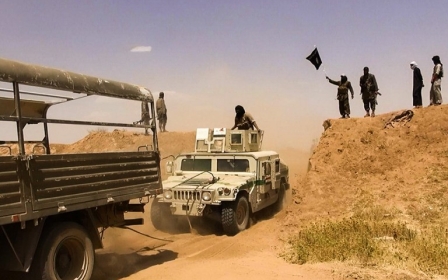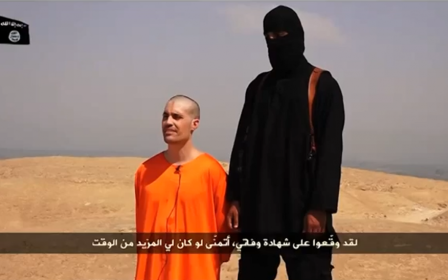Voices: How has the Islamic State been able to expand and what can stop it?

(AFP PHOTO/HO/WELAYAT RAQA)
JOHN ESPOSITO, Director of the Prince Alwaleed Bin Talal Centre for Muslim Christian Understanding at Georgetown University
@JohnLEsposito
The Islamic State's expansion has been made possible by political conditions in Syria and Iraq, ethic-religious/sectarian divisions and conflicts as well as in the region, and the failures of the US and international community. Syrian President Bashar al-Assad’s unprincipled and disproportionate military response to the “threat” of the democratisation wave, the Arab Spring, with the slaughter of Syrian opposition groups, both radicalised the situation and heightened sectarian (Sunni-Shia or Alawi) divisions. Outgoing Iraqi Prime Minister Maliki’s policies - installing a Shia-dominated government, marginalising Sunnis and taking control of parts of Anbar province - increased an already polarised situation and sectarian violence that have resulted in alienated Sunnis welcoming IS. IS's expansion so far has been mostly in areas of Iraq that are either primarily Sunni or have important Sunni populations in them. The situation was compounded by Gulf funding of militant Salafi jihadists, including IS, to fight a proxy war in Syria against Assad. At the same time, the failure early on in Syria of the US and EU, to become significantly engaged and work closely with regional allies like Turkey, and Saudi Arabia to support moderate anti-Assad forces had a ripple effect. The US and EU underestimated the threat from Syria in 2011 and, more recently, in Iraq.
Like al-Qaeda and other militants, IS offers a militant Salafi ideology/religious rationale to justify, recruit, legitimate and motivate many of its fighters. While there is a similar ideological world view and shared tactics between IS and other terrorist groups like al-Qaeda, there are also distinctive differences. IS seeks to occupy and control areas, to govern, not just to dream of or speak of, but to create and impose their version of a transnational caliphate, with its harsh version of law and order and provision of security and social services. At the same time, they are far more aggressive in driving out, suppressing and killing other Muslims (Shia, Sunni imams who disagree with them and Yazidis, for example) and Christians, or demanding conversion to their brand of Islam.
IS will continue for some years to be a threat. Its capabilities will be enhanced by its alliance with al-Qaeda in the Arabian Peninsula. It will also be very difficult for Iraqi and Kurdish forces to recapture most of the lost territory from IS, especially in areas where Iraqi Shia-dominated government and the Kurds are viewed as enemies rather than allies. Thus, it will be important for the new Iraqi government to form a significantly more inclusive representative government and policy. Given the current momentum of IS and its stated intentions to expand its caliphate, the group may well increase its activity in northwest Syria, southern Iraq, Jordan, Lebanon, and southern Turkey.
Although not a game changer, a coordinated regional and global response by Muslim religious leaders and Islamic organisations that denounces and discredits IS's religious claims and actions in the name of Islam could be useful. While some have spoken out, globalised communications enables a far more massive and effective response. It might be possible to make gains in responding to IS if there were a real US and international commitment. Having disengaged from Iraq and Afghanistan, and having taken a minimalist approach in Syria and underestimating the threat from the deteriorating situations in Syria and Iraq, there is no reason or significant indication thus far that US President Barack Obama will move in that direction.
JULIEN BARNES-DACEY, Senior Policy Fellow in the European Council on Foreign Relations' Middle East and North Africa Programme
@jbdacey
The rise of the Islamic State has been fuelled by the perceived exclusion and helplessness of Sunnis in both Syria and Iraq, and enabled in particular by the brutal conflict in Syria which has acted as a mobilising space for the jihadist group. The material gains and momentum of its recent surge into Iraq is now helping to consolidate its position and draw in wider support.
Given its ideology, it’s clear that IS will ultimately need to be stopped militarily. But that can only happen on the basis of two pre-requisites: First, drawing away some Sunni support from IS in Iraq that empowers local push-back against the group (as opposed to depending on problematic Western military intervention).
But secondly, a strategy focused solely on Iraq won’t be enough. IS’s recent gains are based on its presence in Syria, and any meaningful attempt to stop the group will have to also go after it there. Given that the threat posed by Islamic State has created an unprecedented convergence of regional interests, there may be an opportunity to revisit the potential for regional deal making on Syria, drawing in the Saudis and the Iranians towards some kind of power sharing agreement based around the need to push back against the Islamic State. It’s a long shot, and clearly actors on the ground aren’t moving there yet, but the provision of arms and direct military attacks are fraught with uncertainty and the prospects of success are so slim that an opportunity to explore regional convergence - as is already happening in surprising ways in Lebanon and Iraq - may represent the best way forward.
AHMED MEILOUD, doctoral candidate at the University of Arizona's School of Middle Eastern and North African Studies
@AhmedMeiloud
The rise of the Islamic State from the Syrian fratricide caught many by surprise. However, most keen observers knew that Iranian and Lebanese support would slow, but not prevent Assad’s demise. This recognition led global players to intervene. After attempts to form a secular opposition failed, the focus shifted to sowing discord between the Islamists to buy time and to stem the support pouring from the Sunni world. The plan worked, but its engineering failed. It eventually led to a dramatic - although in hindsight predictable - consequence: The cohesive and war-hardened men of IS won. In the process of crashing others, IS abandoned its guarded stance, declared its supra-national agenda and proceeded to vigorously pursue it on the ground.
Access to weakly defended weapons warehouses in Syria, extended experience with asymmetric combat, and fresh boosts of morale and volunteers allowed IS to use raids on Assad forces as a regular weapon-procurement scheme and its clashes with Iraqi forces as a recruitment tool within its Sunni constituents.
As a fighting force, IS possesses four strengths that make it the most lethal ground force in the region: 1. Brutality: It seldom takes prisoners; 2. Dedication: Its soldiers came to die for a cause. Despite its near annihilation in 2010, the movement never had a shortage of suicide bombers; 3. Mobility: most of IS’s attacks are marked by speed and surprise; and 4. Wide expertise in warfare: No regional army had fought in the past decade as many battles as IS core fighters have, using all means to bleed its often better-armed adversaries.
Despite these strengths, IS has some weaknesses. One of these is its image. The further its image is disfigured before Sunni Muslims, the more its recruitment line suffers. IS’s opponents are quite conscious of this and have sought to spread many tales of horror about its mistreatment of civilians. While most of the accounts of mass rape, forced marriages and sexual slavery have proved to be fabrications, IS’s display of mass execution of war prisoners united its foes and alienated its friends. Another flaw is the lack of aerial force or air defence systems. Further, IS’s flaws lie in its inability to win over key Iraqi nationalist groups. These are silent for now but could switch sides or wait it all out. The latter option is the best that IS could hope for. The signs of new sahawat [anti al-Qaeda Iraqi Sunni groups] are already looming on the horizon.
Although IS has managed to quickly overrun the US-trained and funded Iraqi army, the Kurdish Peshmerga and many divisions of the Syrian army - and would have done as well pushing the Kuwaitis or Jordanians - it is not invincible. The Iraqi terrain makes it extremely vulnerable to American airstrikes and its rapid expansion has left it thinly stretched. In the case of extensive air campaigns, IS’s mobility and access supply roads might be severely limited. This would give the weakened Peshmerga and other Iraqi militias some edge over IS.
But IS’s raison d'être is not territorial gains or established institutions, but rather its ideological commitment and the grievances it claims to respond to. If the sectarian problems in Iraq are not addressed, and if the general grievances against Western meddling in Muslim affairs are not properly resolved, Muslim youth, especially Sunnis, will continue to seek military methods to pursue their dreams. Battling already with a sense of injured pride and a sense of limited options, Sunni militants are unlikely to crash in the long term. The official Sunni world - except for perhaps Turkey and Qatar - has mostly been discredited and is, at its current state, incapable of providing an acceptable alternative to a caliphate dream. In the long term, a unified Sunni state, in Syria, Iraq and perhaps beyond, is inevitable.
Stay informed with MEE's newsletters
Sign up to get the latest alerts, insights and analysis, starting with Turkey Unpacked
Middle East Eye delivers independent and unrivalled coverage and analysis of the Middle East, North Africa and beyond. To learn more about republishing this content and the associated fees, please fill out this form. More about MEE can be found here.




